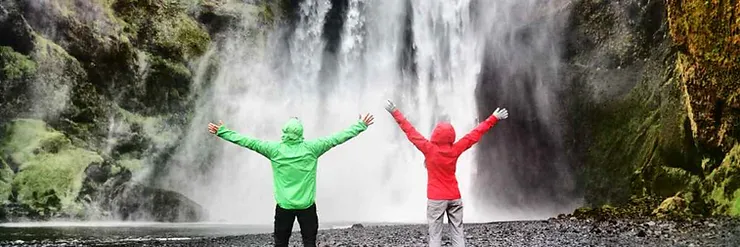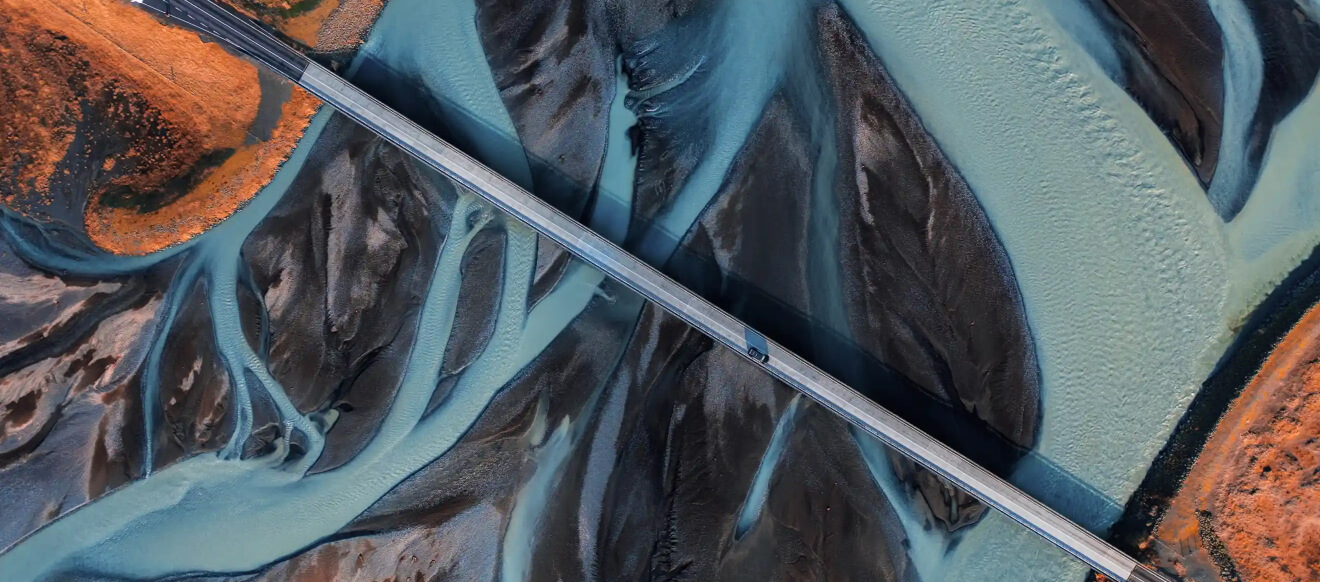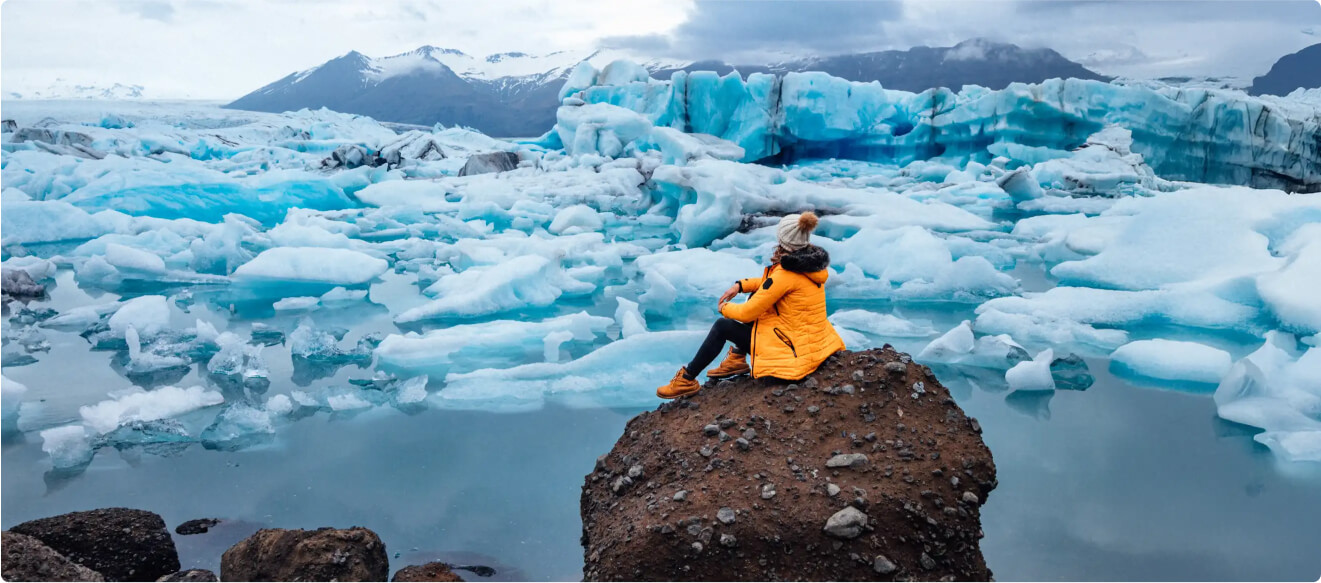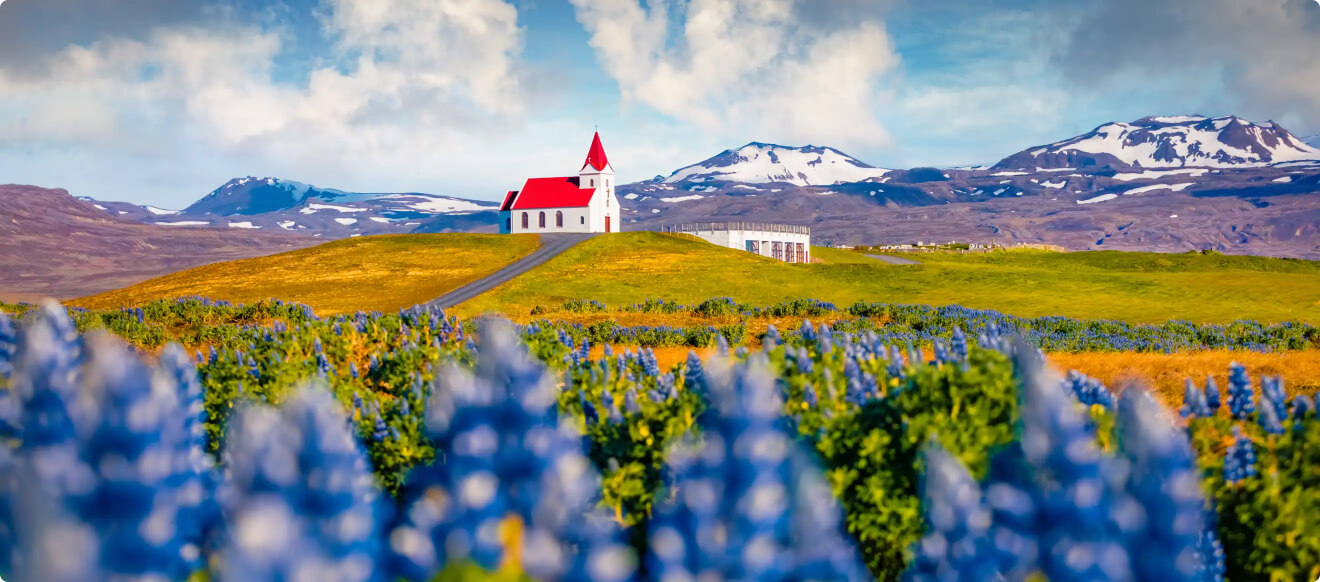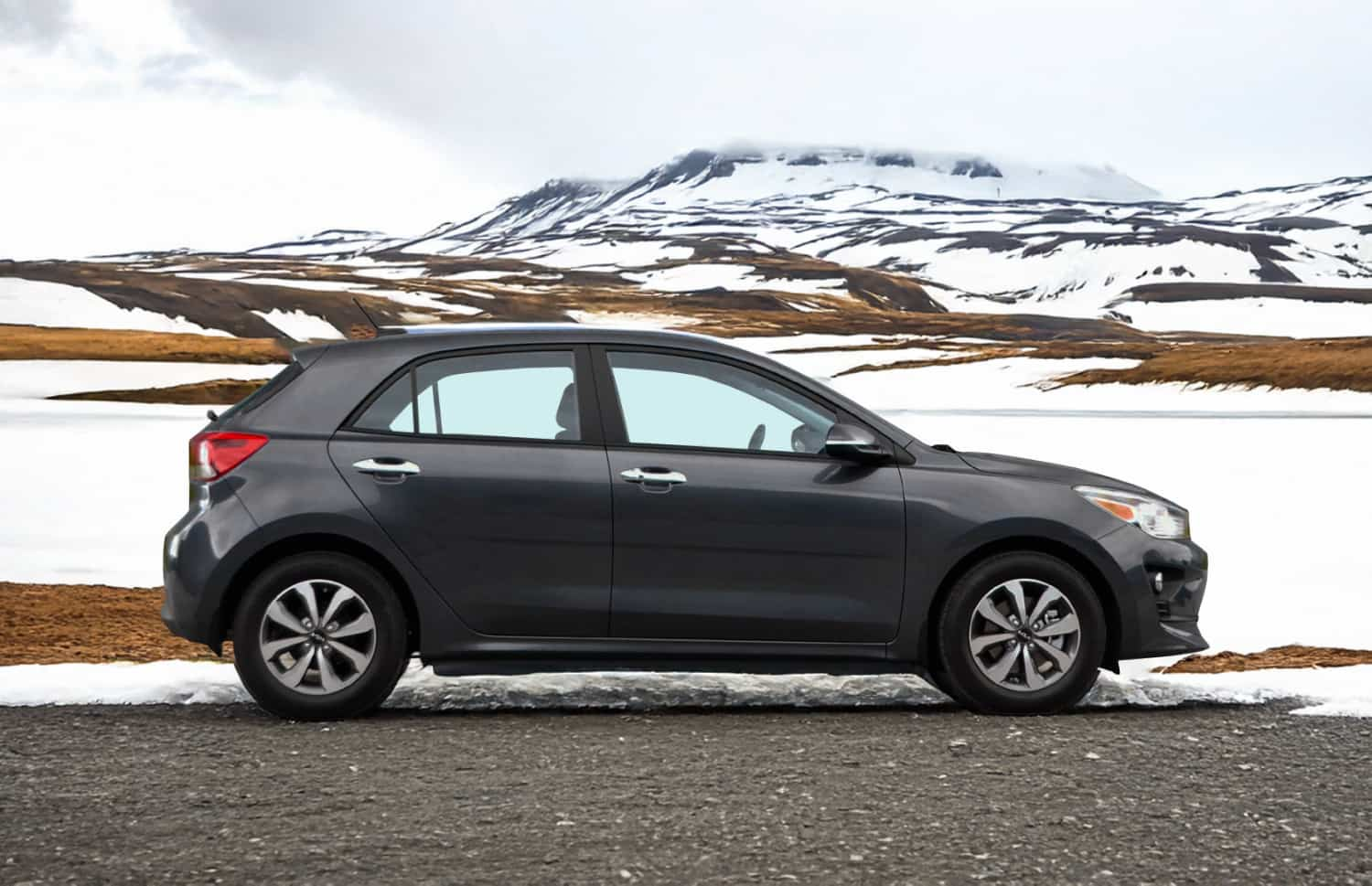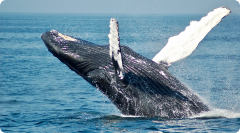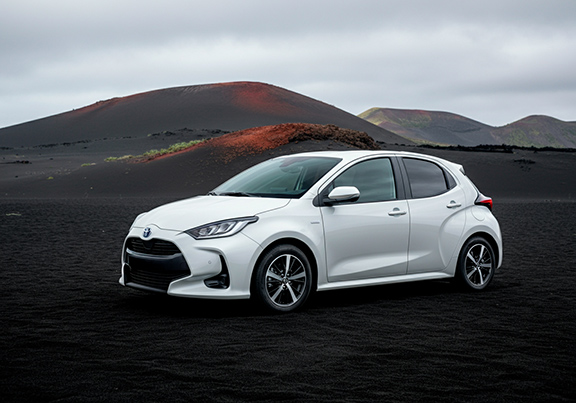Are you looking for a breathtaking adventure in the land of Fire and Ice? Look no further than the country's magnificent waterfalls! With over 10,000 waterfalls across the country, Iceland boasts some of the most stunning natural wonders in the world.
Among them are the 20 best Iceland waterfalls that will leave you speechless with their beauty and power. From the majestic Gullfoss to the secluded Gljufrabui, each waterfall is uniquely mesmerizing in its own right.
So pack your bags, grab your camera, and get ready to discover the enchanting beauty of Iceland's waterfalls!
1. Glymur – 2nd Tallest Waterfall in Iceland
Glymur Waterfall is one of the most stunning Iceland waterfalls in West Iceland. At 198 meters (650 feet) tall, it is the second-highest waterfall in Iceland and the tallest that can be easily accessed on foot. The waterfall is fed by the river Botnsá and is surrounded by lush green valleys and fjords.
The hike to Glymur Waterfall is an adventure, with two river crossings and plenty of beautiful scenery. As you ascend to the summit, prepare for a stunning panorama of magnificent waterfalls cascading into an azure pool beneath. This awe-inspiring sight will enchant your eyes; it won't soon be forgotten!
If you want an even more thrilling experience, you can take a guided tour of Glymur Waterfall. These tours offer an up-close look at this majestic natural wonder and insight into its history and geology. You can also take a drone tour of the area to get a bird's-eye view of this incredible landscape.
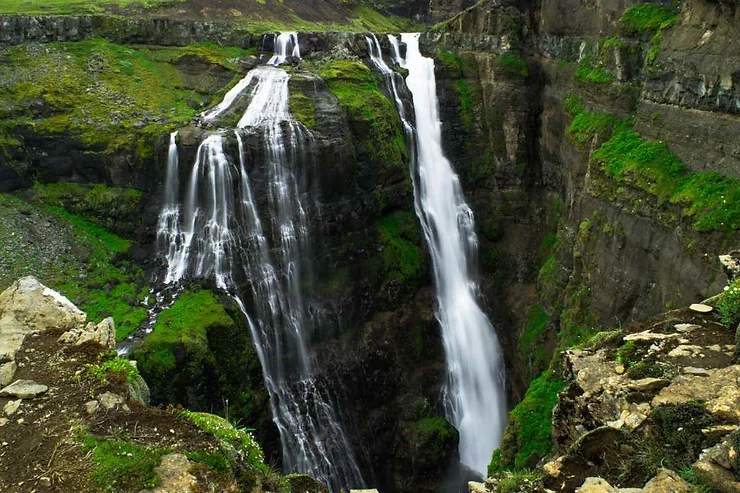
2. Háifoss – 5th Tallest Waterfall in Iceland
Awe-inspiring and exquisite, Háifoss is the fifth-tallest waterfall in Iceland at an impressive 121 meters (396 feet). You'll find it near the Hekla Volcano in south Iceland, a majestic sight you won't want to miss.
The waterfall is situated along the Fossá river and is surrounded by breathtaking views of nature. The area is known for its dramatic cliffs and rugged terrain, making it an ideal spot for sightseeing and photography. Visitors can take in the stunning views from both sides of the falls. And from a nearby bridge that crosses over to Granni Falls, located just next to Háifoss.
Hiking to Háifoss is a popular activity among tourists and locals alike. The hike takes about two hours round trip and can be done any time of year. It's important to note that due to its remote location, it's best to bring plenty of water and snacks with you on your journey. Additionally, visitors should wear sturdy shoes, as some parts of the trail can be pretty slippery due to ice or snow during winter.
Once you reach Háifoss, you'll be rewarded with outstanding views of nature and a chance to witness one of Iceland's most impressive waterfalls up close. If you're lucky enough, you might even catch a glimpse of some local wildlife, such as birds or reindeer, roaming around in the area!
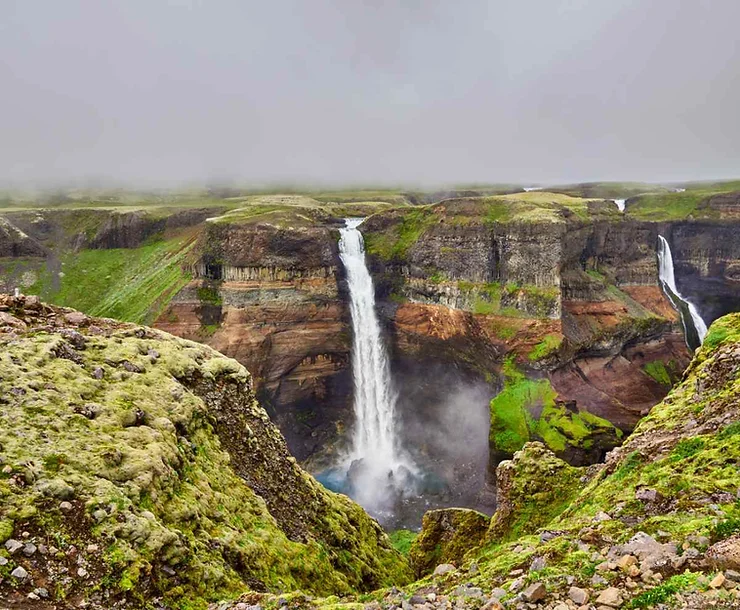
3. Gullfoss – Golden Falls
Gullfoss, also known as the "Golden Falls," is one of the most iconic Iceland waterfalls. It is a two-tiered waterfall that drops 32 meters (106 feet) into a narrow canyon.
The waterfall's name comes from the golden hue the water takes on as it cascades down the rocks. This is especially true during the summer, when the sunlight reflects off the glacial sediment in the water. Located in the southwestern part of the country, Gullfoss is one of Iceland's most visited natural attractions, and for a good reason.
The water feeds Gullfoss from the Hvítá river, which originates from the Langjökull glacier. Visitors to Gullfoss can experience the waterfall in two different ways. The first is from above, where a viewing platform allows visitors to see the entire length of the falls and the surrounding canyon.
The second is by descending a series of steps to a lower viewing platform. These allow you to get much closer to the falls, almost feeling the mist on their faces. Gullfoss also has a fascinating history.
In the early 20th century, plans were made to harness the power of the falls for electricity. However, the daughter of the farmer who owned the land on which Gullfoss sits, Sigridur Tomasdottir, adamantly opposed the project and threatened to throw herself into the waterfall in protest.
Her efforts paid off, and the project was never realized. Today, Gullfoss is protected as a natural monument and is considered one of Iceland's most important environmental sites.
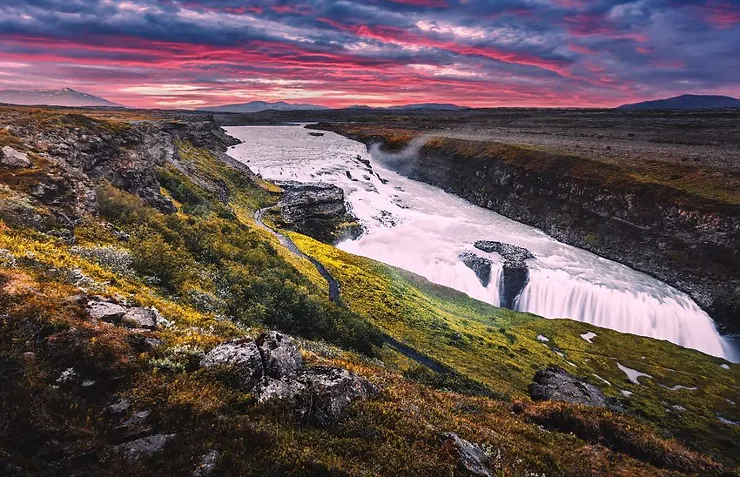
4. Hraunfossar – The Lava Waterfall
Hraunfossar, meaning "lava falls" in English, is a stunning series of waterfalls in the Hallmundarhraun lava field in Borgarfjörður bay, West Iceland. It has a drop of only 12 meters (40 feet) but is known for its beauty and the unique way it formed. At some places, the waterfalls span 547 meters (1500 feet) and are created by rivulets streaming out of the lava field.
The water that feeds Hraunfossar originates from Langjökull glacier. It travels underground through lava fields until it reaches the surface in a series of falls. The creeks of Hraunfossar are fed by a network of underground springs and rivers that are part of the same system as Gullfoss. Visiting Hraunfossar is an experience like no other. As you approach the falls, you can hear the rushing water before getting out of your car.
Once you arrive at the viewing platform, you can take in the breathtaking view of the cascading waterfalls stretching almost a kilometer. The contrast between the black lava and crystal clear blue water is mesmerizing.
The area around Hraunfossar is also full of exciting attractions to explore. Iceland is a hiking paradise, so obviously you’ll find plenty of trails here as well if you want to explore further into nature. Nearby, you will also find Vidgelmir lava-tube cave, Iceland’s largest lava cave, and Reykholt village, home of Snorri Sturluson, a famous Icelandic poet from the 13th century.
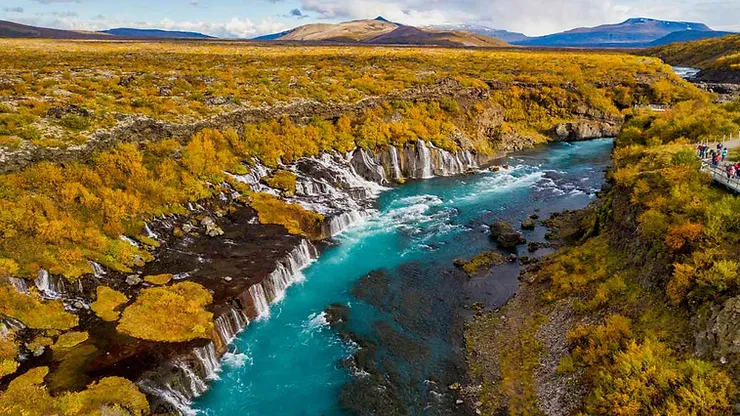
5. Thorufoss – 40 Minutes from Reykjavik
Thorufoss is a stunning waterfall located just 40 minutes from the capital city Reykjavik. The waterfall stands 16 meters (54 feet) tall and is fed by the Laxá í Kjós River. It is often overlooked due to its location off the main road, but it's one of the top waterfalls in Iceland.
Visiting Thorufoss is an unforgettable experience. The best way to visit this attraction is on a self-drive tour in Iceland. It allows you to explore the area at your own pace and take in all the breathtaking views. The drive is quite scenic, with rolling hills and lush green valleys. Once you arrive at Thorufoss, you can admire its beauty up close. You can even dip in the river if you're brave!
The surrounding area of Thorufoss also offers plenty of activities for visitors to enjoy. Several hiking trails nearby provide spectacular views of the waterfall and surrounding landscape. If you're looking for something more adventurous, several rafting tours are available that will take you down the river and past Thorufoss.
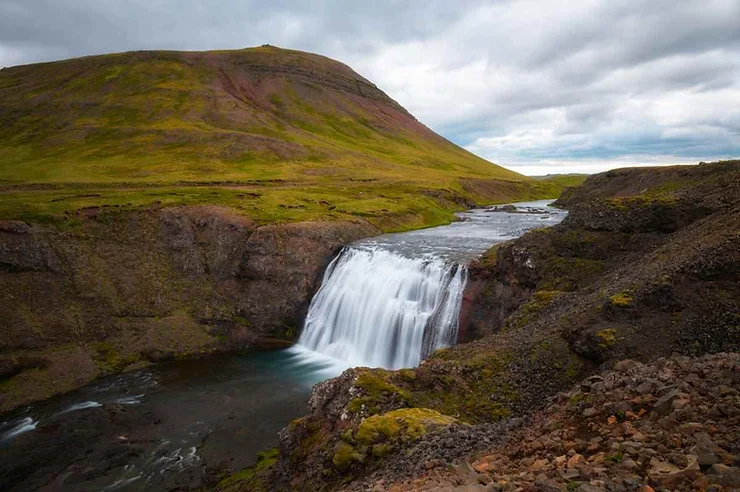
6. Skogafoss – Forest Falls
Skógafoss, or "Forest Falls" in English, is the best waterfall in Iceland for those who want to get up close and personal with its cascading waters. Located on the south coast of Iceland, Skógafoss is a 69-meter (227 feet) high and 30-meter (100 feet) wide waterfall cascading down from the cliffs above. Its impressive size and beauty make it a must-see destination for any traveler to Iceland.
The view of Skógafoss is genuinely breathtaking. The mighty cascade of water creates a misty spray that can be seen from miles away, while rainbows often appear in its midst. On sunny days, visitors can witness an incredible double rainbow arching over the falls. This natural wonder has inspired many photographers and artists to capture its beauty on film and canvas.
Plenty of hiking trails are nearby for those wanting to explore this stunning landscape. Visitors should also explore the nearby village of Skogar, inhabited since Viking times. Here you can find a museum dedicated to Icelandic culture and several shops selling local handicrafts and souvenirs.
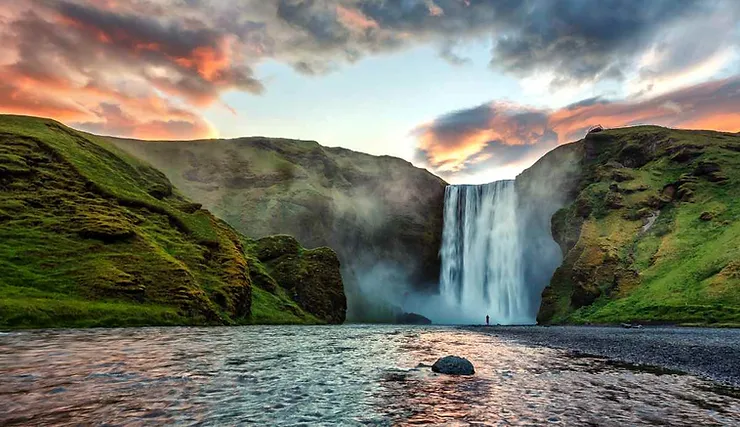
7. Seljalandsfoss – Sea Lands Falls
Seljalandsfoss is a unique waterfall located in the south of Iceland. It's one of the most famous waterfalls in Iceland and is a 2-hour drive from Reykjavik, making it a great day trip destination. The waterfall has a drop of 61 meters (200 feet). It is surrounded by cliffs, making it possible to walk behind it for an unforgettable experience.
The surrounding area of Seljalandsfoss is full of natural beauty, with lush green hills and valleys that stretch as far as the eye can see. The nearby Gljufrabui Waterfalls are also worth visiting; these hidden gems are tucked away in a narrow ravine and offer spectacular views of the falls from different angles.
Seljalandsfoss is close to the Golden Circle, which includes other popular attractions such as Gullfoss Waterfall, Thingvellir National Park, and Geysir Hot Springs.
This makes it easy to combine your visit to Seljalandsfoss with other must-see sights in Iceland. When visiting Seljalandsfoss, bring appropriate clothing and footwear, as you'll likely get wet while walking behind the falls. You should also be prepared for strong winds and cold temperatures if you plan to explore the area during winter.
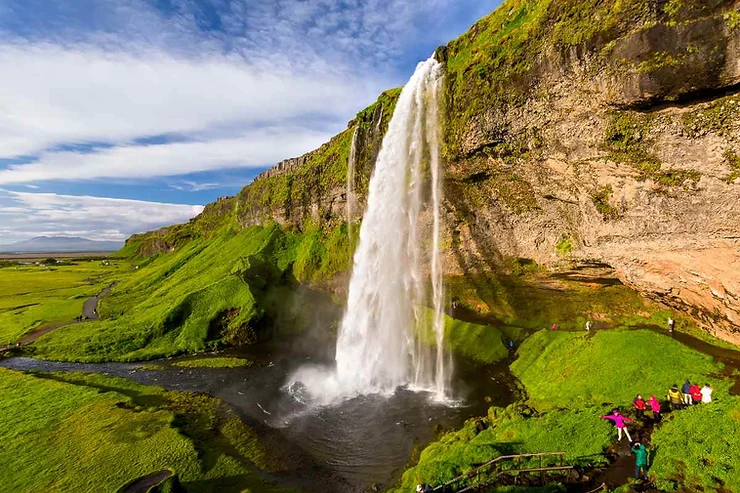
8. Kirkjufellsfoss – Church Mountain Falls
Kirkjufellsfoss - Church Mountain Falls is one of Iceland's most iconic and picturesque sights. It's 16 meters (53 feet) tall, cascading down the slopes of a distinctive mountain called Kirkjufell in Icelandic.
Located on the Snæfellsnes Peninsula, it is a stunning waterfall framed by the majestic Mt. Kirkjufell. This mountain stands 463 meters high and is the most prominent mountain in Grundarfjörður, making it a landmark of the fishing town.
The view of Kirkjufellsfoss and Mt. Kirkjufell at sunset is breathtakingly beautiful. The waterfall itself is short but well-situated, cascading down from the top of the mountain into a pool below.
The name "Church Mountain" comes from its unique shape, which resembles a church steeple when viewed from certain angles. Visiting this great site is an experience that should not be missed! Several hiking trails around Mt. Kirkjufell offer stunning mountain views and the waterfall.
For those who don't want to hike, there are plenty of nearby lookout points where you can take in the breathtaking scenery without exerting too much! If you're lucky enough to visit during wintertime, you may even see Kirkjufellsfoss covered in snow or ice – something extraordinary to behold!
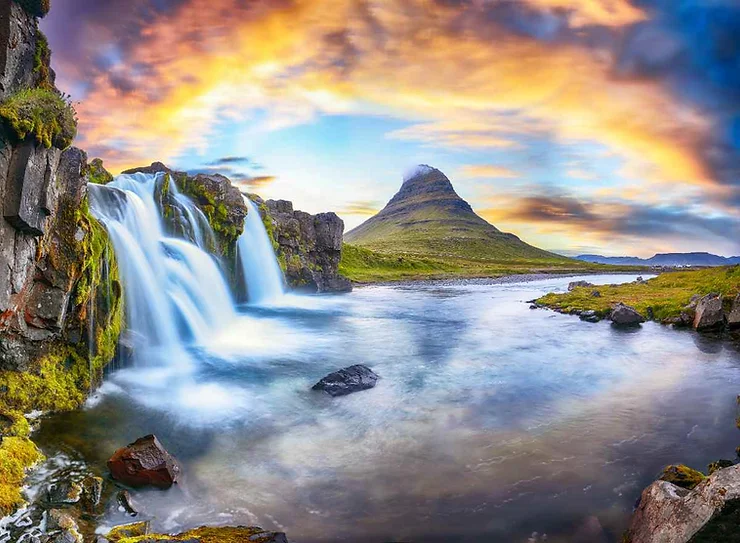
9. Bruarfoss – Bridge Falls
There are plenty of waterfalls near Reykjavik, but Bruarfoss is probably one of thee most stunning Icelandic waterfalls in the South, roughly 1 hour and 20 minutes away from Reykjavik.
It is a relatively small waterfall compared to many of its Icelandic counterparts. Still, it has an impressive horseshoe shape and mesmerizing beautiful colors that make it stand out. The name "Bridge Falls" comes from an old stone archway that once stood over the narrowest part of the waterfall.
The Bruarfoss Waterfall is located on the Brúará river and is approximately 3 meters (10 feet) high. Its unique shape and color are caused by the glacial sediment that runs through it, giving it a milky blue-green hue.
The best way to experience this natural beauty is to hike to get up close and personal with the falls. The hike to Bruarfoss starts at the parking lot near Brekkuskógur, which can be reached by taking Route 35 from Selfoss.
From there, you must walk around 30 minutes along a gravel path until you reach the bridge over the river. Once you have crossed over, you can see Bruarfoss in all its glory! Plenty of activities are available nearby if you're looking for something more adventurous than just admiring Bruarfoss from afar.
You can hike up nearby mountains, kayak on the river, or even take a horse tour. You can also explore some of Iceland's other waterfalls, such as Gullfoss or Seljalandsfoss, within easy driving distance from Bruarfoss.
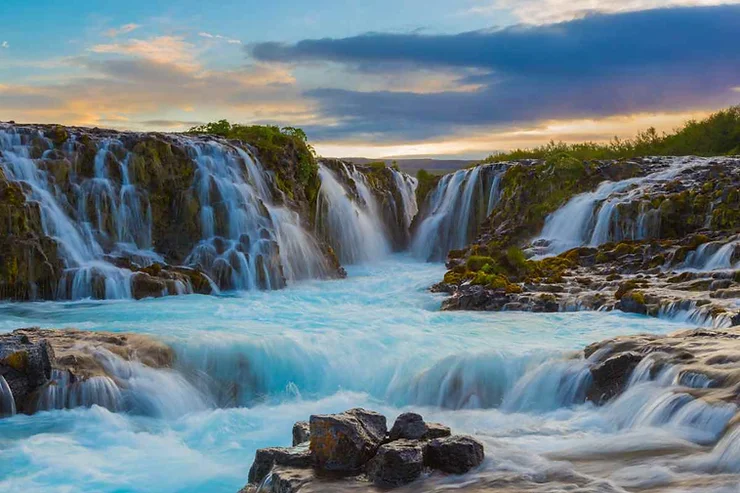
10. Svartifoss – Black Falls
Svartifoss, or Black Falls, is one of Iceland's most unique and beautiful waterfalls. Located in Skaftafell Nature Reserve, which has been part of Vatnajökull National Park since 2008, Svartifoss is fed by ice-cold meltwater from the Svinafellsjokull glacier. As it cascades down 20 meters (65 feet) over a cliff face, it is surrounded by dark lava columns created when lava cooled very slowly over time.
The hexagonal basalt columns make Svartifoss so unique and have become an iconic feature of the waterfall. They starkly contrast the white water flowing over them and create an incredible sight.
The surrounding landscape also adds to the beauty of this natural wonder, with lush green vegetation and snow-capped mountains in the background. Visitors to Svartifoss can hike along the Waterfalls Trail for 1.5 kilometers (1 mile) out and back from Skaftárhreppur in Southern Iceland.
This trail is generally considered easy, but can be pretty steep as it takes you up close to the waterfall. Along the way, you'll get stunning views of nearby attractions such as Manusafoss and Fjallsarlon Glacier Lagoon. Once you reach Svartifoss, you can take in all its glory and appreciate why it's one of Iceland's most famous sights. There are also plenty of photo opportunities here, so don't forget your camera.
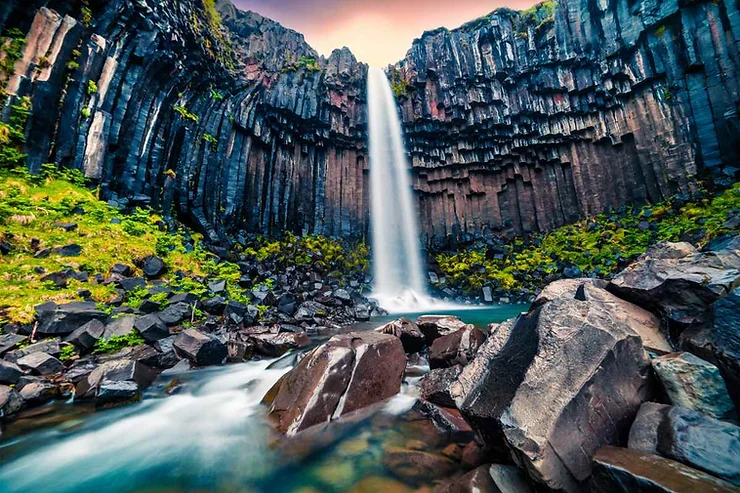
11. Gljúfursárfoss – Ravine Falls
Gljúfursárfoss is a captivating waterfall nestled in Vopnafjordur, Iceland. Measuring 45 meters (148 feet) tall and connected to the Glúfursá River, this mighty cascade rushes through an enthralling narrow gorge. The breathtaking vista at the falls provides visitors with a one-of-a-kind sightseeing experience they won't soon forget!
Visitors can access the waterfall from a small parking lot nearby.
From there, they can take in the beauty of the falls and explore the surrounding area. Many trails lead to different vantage points of the falls, allowing visitors to get up close and personal with this natural wonder. The best time to visit Gljúfursárfoss is during summer, when the weather is warm and sunny. You can swim in the river or dip in its many pools during this time.
You can also explore some nearby caves, providing an exciting insight into Icelandic culture and history. If you want something more adventurous, consider participating in one of Skógafoss's cave tours. This tour will take you through some of Iceland's most spectacular caves while providing breathtaking views of Skógá River's 60-meter (197 feet) cascades.
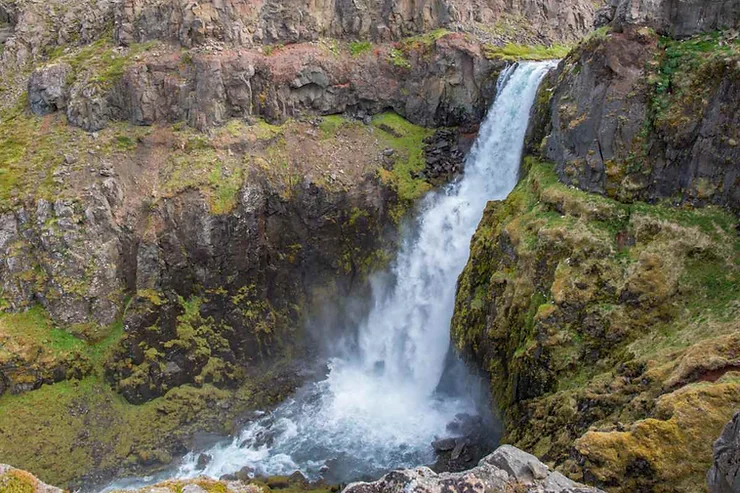
12. Dettifoss – Largest Waterfall In Iceland
Dettifoss is the biggest waterfall in Iceland, located in Vatnajökull National Park in Northeast Iceland. It is also considered the most powerful waterfall in Europe, with 193 cubic meters (6,816 cubic feet) of water per second plunging over its 51-meter (167 feet) high and 171-meter (560 feet)wide edge. The name Dettifoss translates to "The Collapsing Waterfall."
Embark on a journey to Dettifoss from the west, where you can marvel at its thunderous cascade of water. Soak in the remarkable views of the surrounding canyon and appreciate nature's sheer power that has crafted this majestic site. Alternatively, venture eastwards for an idyllic atmosphere with a more manageable path and perfect settings for photography. Here you can savor Dettifoss' beauty in all its tranquility.
The Diamond Circle offers many activities for visitors, such as hiking, bird watching, fishing, or just taking in all the natural beauty of Iceland. For those looking for a more adventurous experience, several tour companies offer guided tours of Dettifoss and its surrounding areas. These tours usually include visits to nearby attractions such as Godafoss Waterfall or Jökulsárlón Glacier Lagoon.
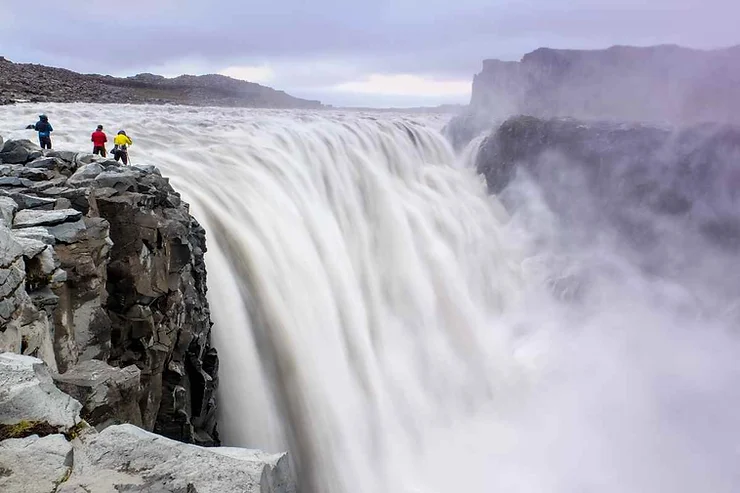
13. Selfoss – Rapids Falls
Selfoss Waterfall is one of the most beautiful and powerful waterfalls in Iceland. Located in Jökulsárgljúfur canyon in the northern region of Iceland, Selfoss is just one kilometer (0.6 miles) south of the enormous Dettifoss waterfall.
Its taller neighbor often overshadows it, but it is worth visiting for its unique beauty and power. Selfoss is 13 meters (44 feet) tall, and its width varies from 378 meters (1,270 feet) to 518 meters (1,700 feet).
The waterfall is a horseshoe-shaped cascade that drops over several waterfalls about 30 km before flowing into the sea. The river Jökulsá á Fjöllum, which feeds Selfoss, originates from the Vatnajökull glacier and carries with it an immense amount of glacial meltwater. This makes Selfoss one of the most powerful waterfalls in Europe. Visiting Selfoss Waterfall can be done independently or as part of a Diamond Circle tour.
The best way to experience it is to hike upriver from Dettifoss and simultaneously take in both waterfalls. The views are spectacular, and you can appreciate their power and beauty from different angles.
If you plan to visit Selfoss Waterfall independently, plan your trip carefully, as no roads lead directly to it. You can either rent a 4x4 vehicle in Reykjavik or hike upriver from Dettifoss along the Jökulsá á Fjöllum riverbed for about 1 km (0.6 miles) until you reach Selfoss Waterfall.
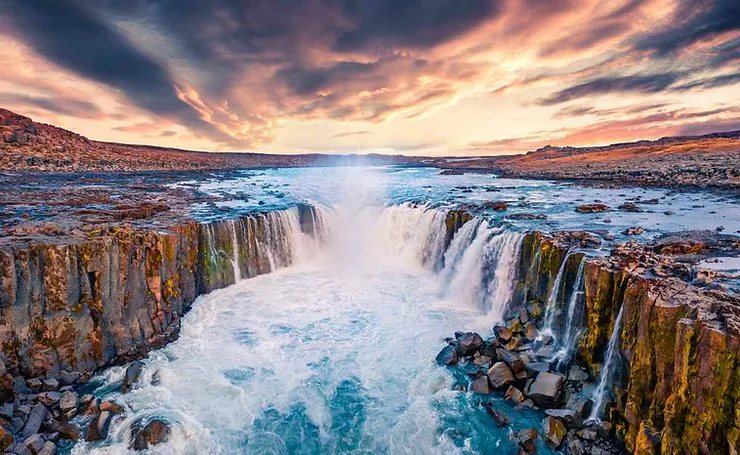
14. Hafragilsfoss – Cliffside Falls
Hafragilsfoss waterfall is a stunning natural wonder located in North Iceland. It is one of three waterfalls on the Jökulsá á Fjöllum river and is known for its spectacular views and thunderous roar. The waterfall stands 27 meters (89 feet) tall and 128 meters (420 feet) wide, making it a powerful sight. The Hafragilsfoss waterfall is surrounded by cliffs that create a breathtaking visitor backdrop.
The area around the waterfall has been declared a national park, so you can explore the surrounding nature while admiring the beauty of the falls. You can also take advantage of nearby hiking trails that offer stunning views of the falls from different angles.
The Hafragilsfoss waterfall is downstream from Dettifoss, Europe's most powerful waterfall. While not as dramatic as Dettifoss, Hafragilsfoss still offers an impressive display of power and beauty.
Those who visit both waterfalls will be able to appreciate their differences in size and forcefulness. Seeing Hafragilsfoss is an unforgettable experience that should not be missed when visiting North Iceland.
The area around the falls offers plenty of activities for visitors, such as fishing, kayaking, bird watching, and more. Visitors can also use nearby restaurants and cafés to refuel after a day of exploring this beautiful natural wonder.

15. Godafoss – Waterfall of the Gods
Godafoss, or the "Waterfall of the Gods," is one of Iceland's waterfalls you don't want to miss. Located north of Iceland on the Skjálfandafljót river, this waterfall stands 11 meters (37 feet) tall and 113 meters (370 feet) wide. It's a breathtaking sight and a must-see for any traveler visiting Iceland. The history behind Godafoss is as fascinating as its beauty.
According to legend, it was here that the lawspeaker Þorgeir Ljósvetningagoði threw his idols into the waterfall after converting to Christianity in 1000 AD. This event marked a turning point in Icelandic history and helped shape the country into what it is today.
Visiting Godafoss is easy and can be done as part of a day trip from Akureyri or Lake Myvatn. Plenty of parking spots are available nearby, and even guided tours are available if you want to learn more about its history and significance.
The best time to visit is during summer, when you can enjoy the warm sunshine while admiring its majestic beauty. When you arrive at Godafoss, you will be greeted by stunning views of cascading water surrounded by lush green hillsides and snow-capped mountains in the background. The sound of rushing water combined with birdsong creates an atmosphere that is both calming and energizing at the same time.
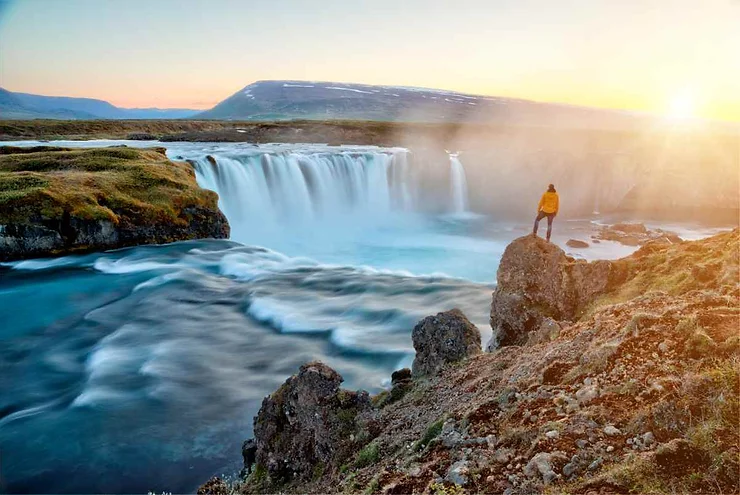
16. Faxi or Vatnsleysufoss – Empty Waterfall
Faxi or Vatnsleysufoss is a beautiful waterfall by the Golden Circle, a popular tourist trail east of Reykholt in South Iceland.
This majestic waterfall is also known as Fossin Faxi and is part of the Tungufljót river. It's 91 meters (300 feet) wide and 7 meters (22 feet) tall waterfall, making it an ideal spot for visitors looking for a less busy Golden Circle experience.
The Faxi waterfall is surrounded by lush green hills and mountains, making it a great place to take in the breathtaking views of the Icelandic landscape. The falls are easily accessible from the parking area, so visitors can get up close and personal with this natural wonder. The story goes that when you stand at the top of the falls, you can hear voices from below - this legend has been passed down through generations of Icelanders!
Visitors to Faxi or Vatnsleysufoss should be sure to bring their camera along - there are plenty of photo opportunities here! The best time to visit is summer, when the sun shines brightly on the falls, creating a stunning rainbow effect.
In addition, visitors can enjoy hiking trails nearby and explore other attractions, such as Skalholt Church and the nearby Geysir hot springs.
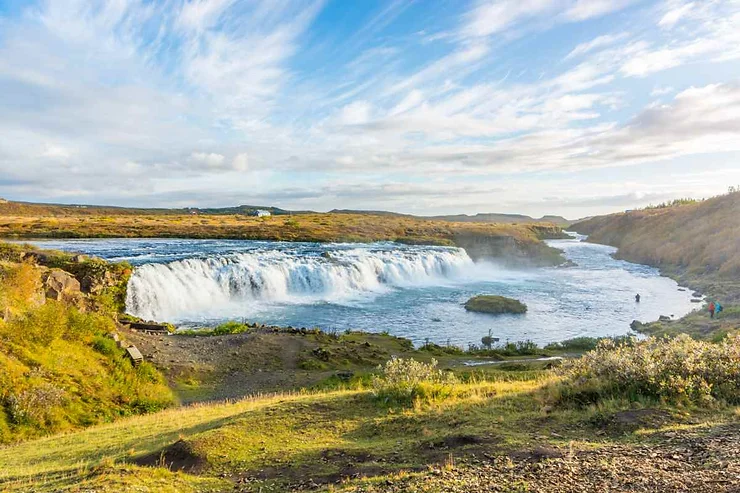
17. Hengifoss – The Hanging Waterfall
Of all the Iceland waterfalls, Hengifoss is one of the most majestic. Located in Fljótsdalshérað, Eastern, this 128-meter (420 feet) tall waterfall is the fourth-tallest waterfall in Iceland.
The hike to Hengifoss is a gradual climb uphill for an hour or so, and it's worth every step. Along the way, you'll pass Litlanesfoss Waterfall, a two-step cascade that adds to the beauty of the journey.
The most striking feature of Hengifoss is its cliff face, composed of remarkable red clay and black basalt patterns. This unique combination creates an impressive backdrop for the mighty waterfall, which drops into the Hengifossárgljúfur gorge below. The view from the top is breathtaking and will leave you speechless with its sheer beauty.
Hiking to Hengifoss can be done year-round, but it's best done during the summer when there's more daylight and warmer temperatures. It's also important to note that some guard rails along parts of the trail can still be dangerous due to slippery surfaces and steep inclines.
If you're located in east Iceland and are searching for ideas on where to explore, be sure to check out our article on the 15 Places To Visit in East Iceland!
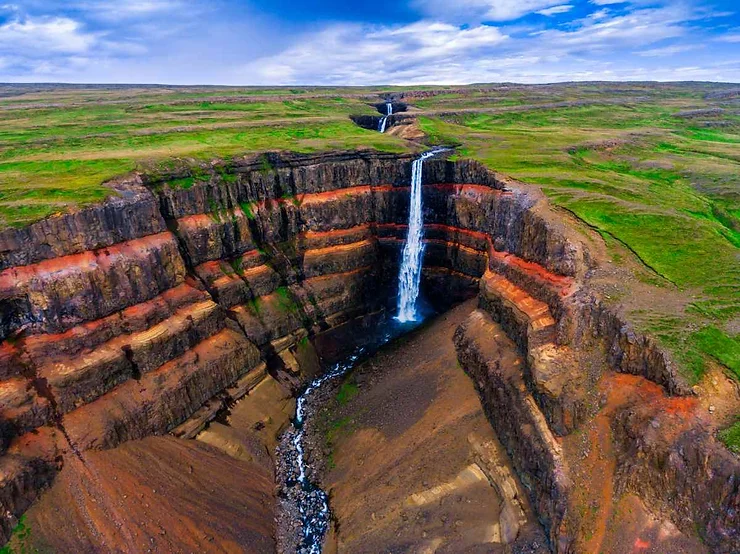
18. Hrauneyjafossar (Lava Islands Falls) – Lava Islands Fall
Hrauneyjafossar, or Lava Islands Falls, is a breathtaking Iceland waterfall in the highlands. The falls are on the Hvítá River, where white water cascades into the turquoise waters below. It is jaw-dropping 900 meters (3,000 feet) wide, making it one of the most impressive falls in Iceland.
It's a popular destination for tourists and locals who enjoy this stunning landscape's natural beauty. The area around Hrauneyjafossar has been shaped by volcanism and covered with tephra, craters, and lava.
A massive eruption in 1477 formed a crater row around Veiðivötn, and south of it lies Sigöldugili canyon, home to the Lekafossar (Leaking Falls). The two falls are separated by a narrow strip of land known as “the valley of tears” due to its cliffs.









